Invasive Aquatic Plants
Hydrilla (Hydrilla verticillata)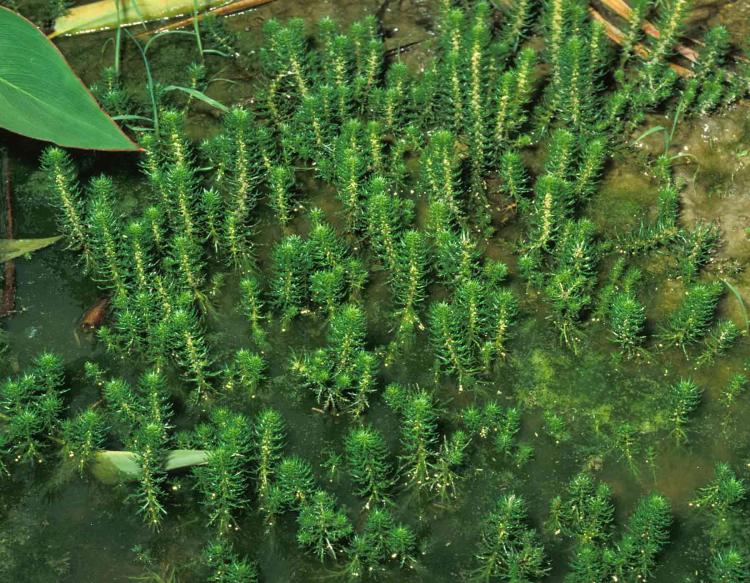
Aslo known as water thyme, Hydrilla is a submersed perennial herb that has pointed, bright green leaves about 5/8 inches long. The leaves grow in whorls of 3 – 10 along the stem. The margins of the leaves are serrated (toothed). The underside of the leaf has a reddish central spine and one or more small spines that give it a rough feeling when rubbed between your fingers. Thin stalks from the stem end in a single, small, floating white flower at the water’s surface. A key identifying feature is the presence of small (up to half inch long), dull-white to yellowish, potato-like tubers which grow 2 to 12 inches below the surface of the sediment at the ends of underground stems. These tubers form at the end of the growing season and serve to store food to allow Hydrilla to overwinter.
Growing up to 25 feet, the stems of this plant are rooted in the bed of the waterbody. With its rapid growth rate and ability to grow in freshwater lakes, streams, canals, and ponds, Hydrilla is highly invasive and can displace native aquatic vegetation. Once esablished Hydrilla forms thick, horizontal mats on the water’s surface, in turn blocking out sunlight that other native aquatic vegetation depends on. These thick mats also impair recreational activites such as swimming, fishing, boating, and in severe cases intakes at water treament faicilities and power plants can be blocked.
To prevent the spread of Hydrilla boaters should follow basic clean boating techniques. Cleaning equipment, watercraft, and trailers before and after activities in the water will help ensure that you will not transfer unwanted plants or plant fragments into water bodies. Physical removal is also reccommended if plant material is building up around your dock or shoreline property. Removed plant material should be disposed of in the trash. Should you discover Hydrilla in a waterbody, please alert the appropriate local agencies such as NYS DEC at 1-866-640-0652 or the National Invasive Species Hotline at 1-877-786-7267.
w
Water Chestnut (Trapa natans)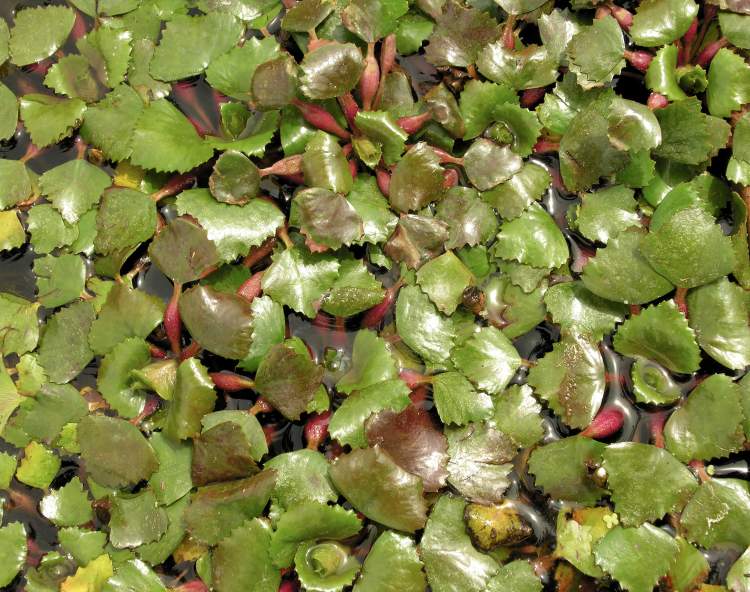
Not to be confused with water chestnut you can buy canned in a grocery store (different species), the European Water Chestnut (Trapa natans) is a highly invasive freshwater plant species. Growing in shallow areas (<16ft) of lakes, ponds, and slow moving streams & rivers, it can form dense mats of floating vegetation.
The European water chestnut is a rooted aquatic plant with submersed and floating leaves. Feathery submersed leaves form whorls around the stem; the 3/4 to 1 ½ inch glossy green floating leaves are triangular with toothed edges. Single, small, white flowers with four 1/3-inch long petals sprout in the center of a rosette. The plant’s cord-like stems are spongy and buoyant, and can reach lengths of up to 16 feet. The stems are anchored to the bed of the waterbody by numerous branched roots.
Adverse affects caused by water chestnut include reduced sunlight penetration, decreased native vegetation growth, safety hazards for boaters and swimmers, and diminished dissolved oxygen levels in the water. Reduced native plant growth combined with decomposition of the water chestnut result in these low oxygen levels, potentially leading to fish kills.
Early detection and rapid response to water chestnut infestations is the most efficient and cost effective course of action. Physical removal can be accomplished by volunteers hand-pulling the plant from canoes or kayaks. Harvesting before the plant forms ripe seeds can be incorporated into a long-term control strategy. Populations must be carefully monitored after removal as seeds can remain viable in sediments for long periods of time.
w
Eurasian Watermilfoil (Myriophyllum spicatum)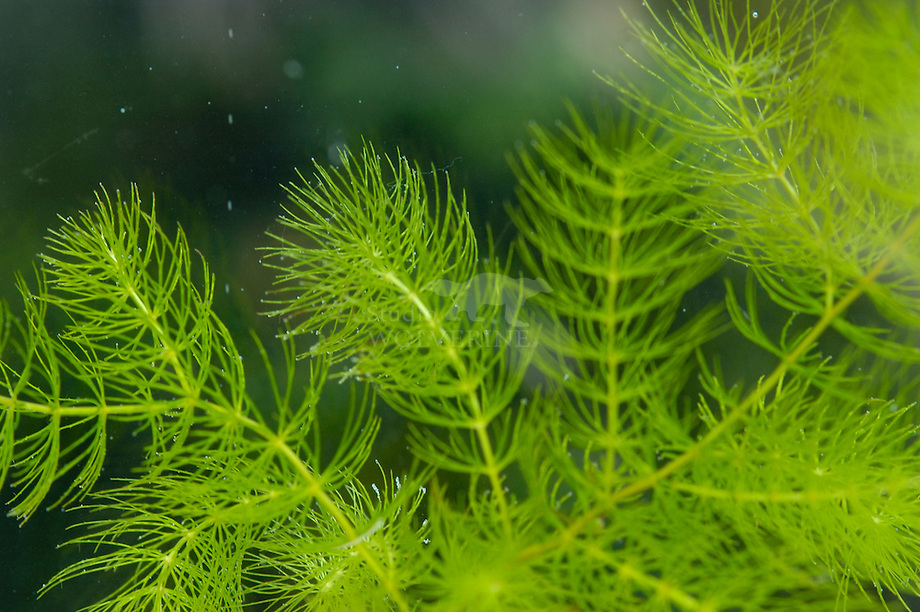
Eurasian Watermilfoil is a submersed, aqautic perennial that roots to the bottom of water bodies. Milfoil can grow up to 21 feet to the water surface, and stem fragments are capable of forming new plants. Often difficult to distinguish from native milfoils, Eurasian watermilfoil’s leaves will fall and relax against the stem when lifted out of the water. The leaves on native watermilfoils, on the other hand, will remain rigid, and spread out from the stem. Native milfoils also have sparse stem branchinig near the water surface, where Eurasian watermilfoil will have abundant branching.
Forming dense weed beds, Eurasian watermilfoil can have adverse affects on native aquatic vegetation that provide food and shelter for waterfowl, mammals, and fish. These dense beds also create habitat for disease-carrying insects, such as mosquitoes. Reduced dissolved oxygen levels and changes in water temperature are also commonly associated with Eurasian watermilfoil infestations. Human recreational activities, such as swimmming, fishing, and boating, are often adversly affected by the growth of this invasive species.
Prevention is the most important management option for Eurasian watermilfoil. This also includes mapping and monitoring of areas of concern. Since stem fragments can establish new plants, people should ensure that their watercraft, trailers, live-wells, boat bilges, and fishing equipment is free of any plant debri, and that any fragments found should be disposed of away from lakes. The key to prevention is to not be a vector!
w
Curly Pondweed (Potamogeton crispus)
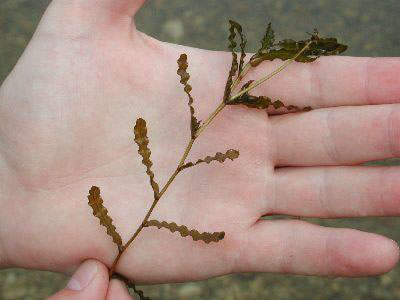 Curly pondweed is a fast growing, perennial aquatic plant. Pondweed is often used to oxygenate ponds, and is usually intentionally introduced through seed propagation. Problems arise when this fast growing plant is not monitored, and left to grow uncontrolled where it can overrun ponds, pools, and canals. Curly pondweed can clog waterways and inhibit aqutic recrational activities such as swimming, fishing, and boating.
Curly pondweed is a fast growing, perennial aquatic plant. Pondweed is often used to oxygenate ponds, and is usually intentionally introduced through seed propagation. Problems arise when this fast growing plant is not monitored, and left to grow uncontrolled where it can overrun ponds, pools, and canals. Curly pondweed can clog waterways and inhibit aqutic recrational activities such as swimming, fishing, and boating.
Careful monitoring of water bodies along with the prevention of intentional/unintentional introduction are the best methods of prevention and control of this species. Again, ensuring that your watercraft, trailer, and fishing equipment is free of plant debri and seeds will help prevent the spread of curly pondweed.
European Frogbit (Hydrocharis morsus-ranae)
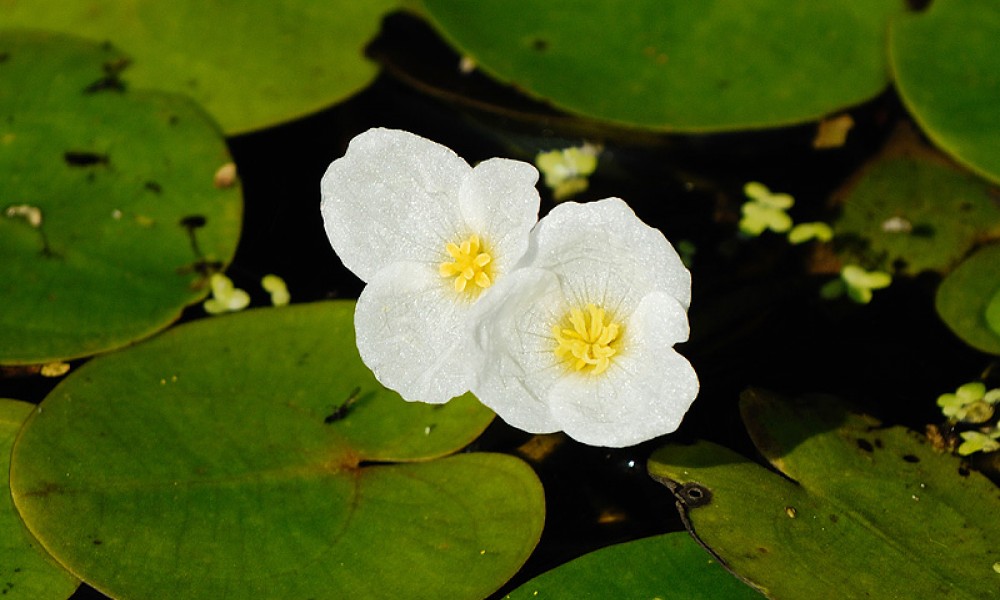 European Frogbit is a free floating aqautic plant with dangling roots. Frogbit has 1-2 inch wide heart-shaped leaves that float on the water’s surface, with each plant prducing a single white flower. It can be found in open water marches, swamps, and backwaters. Frogbit primarily reproduces through turions, which are buds that break off the plant and sink to the bottom where they over-witner. The turions rise to the surface in the spring. A single plant may produce as many as 100 turions. In the fall this plant decomposes and falls to the bottom of the water column, contributing to increased organic biomass accumulation.
European Frogbit is a free floating aqautic plant with dangling roots. Frogbit has 1-2 inch wide heart-shaped leaves that float on the water’s surface, with each plant prducing a single white flower. It can be found in open water marches, swamps, and backwaters. Frogbit primarily reproduces through turions, which are buds that break off the plant and sink to the bottom where they over-witner. The turions rise to the surface in the spring. A single plant may produce as many as 100 turions. In the fall this plant decomposes and falls to the bottom of the water column, contributing to increased organic biomass accumulation.
Forming dense tangled mats of interlocking plants, European Frogbit can choke out water bodies and native plant species. These tangled mats can also interfere with recreational activities, such as swimmming, fishing, and boating. Additionally, as Frogbit dies and decomposes it uses up vital dissolved oxygen in the water. If dissolved oxygen level get too low fishkills can result.
Since Frogbit can spread through improper disposal and by clinging to watercraft, trailers, and equipment, prevention is one of the most important management options. Boats, motors, and trailers should be inspected, and any aquatic plants/animals should be removed. Water from the livewell and bilge should be drained before leaving. Any unwanted plants should be disposed of in the trash, away from the water body, and aquatic plants should never be dumped from one water body into another. Infestations can be physically removed by hand or through other harvesting methods.
For a full list of invasive aquatic plants in or around our region, see the FL-PRISM list of aquatic invasive species: http://fingerlakesinvasives.org/species_environments/aquatic/
